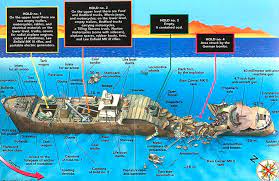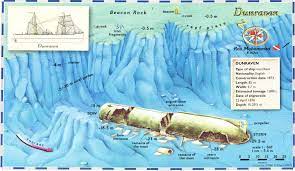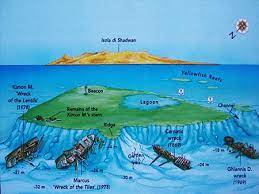Red Sea Wrecks
Red Sea Wrecks
SS THISTLEGORM
The SS Thistlegorm is one of the most famous wrecks in the world. Built in 1940, the SS Thistlegorm was a 126 meter long freighter, carrying military equipment during the World War II. The wreck attracts many divers for the amount of the cargo that can be seen and explored. The wreck of the SS Thistlegorm is like a gigantic, submerged army surplus store. There are strict penalties for wreck-stripping. Please spare yourself the heroics of lootin so do not help yourself to souvenirs.
The marine life around the SS Thistlegorm is spectacular, with the presence of batfish, a resident turtle, barracuda, snappers and schools of jacks. As a matter of fact, what we see here are the usual reef fishes native to the Red Sea.

DUNRAVEN
This wreck of a British Steamer is on the Southern edge of Sha’ab Mahmoud which is also known as Beacon Rock as the wreck is directly below the South Cardinal Beacon.
It is about another hour boat ride past Ras Mohammed.
The Dunraven was built in 1873 in Newcastle and hit the reef in 1876. It has sunk in 30m of water right next to the reef wall and is completely upside down in two sections.
The length is about 80m and it’s about 10m wide.
The stern section is in about 29m to the sand. This leads to a swim through by the side of the ship’s boiler and out where the wreck has broken in half.
The exit being usually filled with glass fish in their thousands. After the bow section the dive is usually done by fining over the hull which is covered in coral and then moving onto the reef wall and the shallows to finish the dive.
This site is a heaven for fans of Stonefish Napoleon Fish and Scorpion Fish.

WRECKS OF ABU NUHAS
About 4 hours of sailing separate Sharm el Sheikh from the aquatic graveyard at Abu Nuhas. This submerged reef has claimed more vessels than any other in the Red Sea. Numerous wrecks lie here and the area is littered with wreckage from other ships.
The opening of the Suez canal in 1869 established the Red Sea as the most important stretch of water near Egypt. The installation of lighthouses and beacons did not keep up with the increase of the shipping activity, hence the excellent wreck diving found here.
At least four complete wrecks lie here. They are the Chrisoula K, the Kimon M, the Carnatic and the Giannis D.
Abu Nuhas is exposed to current and wind, so swelling waves may be inconvenient for divers.
The Carnatic is widely recognized as the most beautiful wreck on Abu Nuhas. The ship, having fallen victim to stormy conditions en route from Bombay to Suez, has been taken over by swaying curtains of glassfish. Adding to the undisputed photogenic quality of this spot is the presence of groupers, lionfish and jackfish.
Giannis D. This ship was bound for Jeddah, sailing from Croatia with a large cargo of wood. She was added to the underwater graveyard at Abu Nuhas in 1983. Most head for the aft section to view the propeller, and some chose to go inside from the aft entrance to visit the Engine Room Divers can then make their way around the wreck and to the amidships and forward sections before finishing the dive at the bridge, and, if the seas above aren’t too rough, along the gentle slope of the reef, where any number of marine species are common, including moray eels, bannerfish and jackfish.
The Chrisoula K was a 98m Greek registered freighter that sank on 31 August 1981, laden with floor tiles. The ship lies with its stern and propeller at 26m and its bow in shallow water at only 3m. It sits more or less upright but the stern is slowly separating. The wreck offers plenty of swim-throughs and penetration diving opportunities but beware of the numerous obstructions such as fallen beams and poles. Its superstructure is now encrusted with a layer of hard corals, and is home to flatworms, lionfish, Arabian Picasso triggerfish, and clown sand wrasse. Dolphins also pass by here occasionally.
The Kimon M is the deepest of the Red Sea wrecks within recreational scuba diving depths here. Its stern lies on the seabed at 32m, with its bow shallower at 15m. This 120m German cargo vessel sank on 12 December 1978, laden with lentils. Initially the boat sat upright on the reef but later currents and wind pushed the ship into deeper water on its starboard side. Much of its cargo and engine were recovered after its sinking. The wreck harbours several different species of pipefish.
Adding to the diving sensation here is the likeability of a pod of dolphins curiously roaming by in the afternoon.

THE KINGSTON
She was commissioned by the Commercial Steamship Company. Like the Carnatic, Ulysses, and other ships of the time, the Kingston was a hybrid of sailing and steam, measured 262 feet long, and weighed 1,449 tons.
The engine, whose model only ten units were manufactured, endowed her with a cruising speed of 10 knots. The Kingston was declared a constructive total loss on the 28 February 1881. After more than 125 years underwater, this wreck is still in remarkable condition.
Half the hull from amidships to the stern is fairly intact but with no superstructure.
The cargo of coal is still in place, Above the stern, are the remnants of the tiller. Nearby is evidence of portholes having been removed.
The wooden decks have gone leaving a series of steel spars and beams. There is also a spare propeller. Amidships are the remains of the engine room with two large boilers and condenser.
The remainder of the ship is nothing more than scattered debris across a coral slope. Two masts lie of the starboard side of the wreck.
THE BARG & WRECK OF ULYSSES
Gubal Island in the Red Sea is a unique and stunning dive site that offers divers of all levels a truly unforgettable experience. Located near a fringing reef near Gubal Island in the northern Red Sea, the actual barge is a wreck dive, but to be honest this is a bit of a stretch as it is just a couple of metal spars sticking out of the bottom at 10-16m depth. Its main strength is that an area around and within the metalwork is washed by a regular, relatively predictable current that brings nutrient-rich water that feeds everything from the bottom up the food chain.
This means that there is plenty of food for everyone here. On a single dive you can see everything from tiny animals, crustaceans and nudibranchs to large schools of fish like sergeant majors and fusiliers, numerous sizes and species of moray eels, dozens of large scorpion and rockfish, and regular visits from turtles and dolphins.
The Ulysses lies up the Reef with her stern at 28m. The front third of the ship is a debris field. The main body of the wreck, however, lies on it’s port side and provides a very interesting dive.
Most of the wooden decking has rotted away revealing a framework of iron supports similar to those of the Carnatic. The stern is beautifully rounded and both rudder and propeller are in place. Bollards, winches, railings and a large tiller are all present.
The main structure is wide open allowing the diver to enter and explore the vessel at two levels down to the keel. Heading forward we eventually exit from the wreck at that point where the ship meets the coral reef.
The rear mast lies across the seabed next to the broken funnel.
